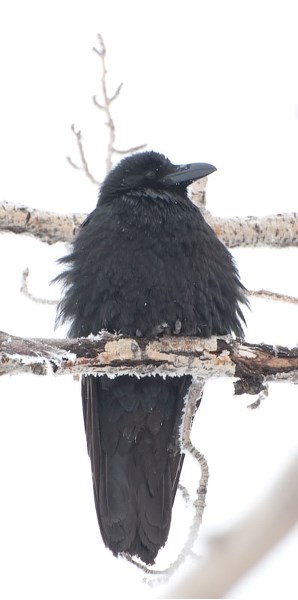Is that a crow or a raven? It's a question many an amateur birder might ask upon seeing a big black bird in St. Albert. And it used to be easy to answer, says Jocelyn Hudon, curator of ornithology at the Royal Alberta Museum.
Is that a crow or a raven?
It's a question many an amateur birder might ask upon seeing a big black bird in St. Albert.
And it used to be easy to answer, says Jocelyn Hudon, curator of ornithology at the Royal Alberta Museum. "It used to be that if you saw a big black bird in the winter, they'd always be ravens." But that's no longer true in recent years, as more crows are starting to overwinter here.
Ravens and crows are much alike. They're black, smart, and talkative, and intimately adapted to urban living.
One way to tell crows and ravens apart is their size. Adult ravens have a wingspan that's over a metre long, reports the Cornell Lab of Ornithology, making them about 50 per cent bigger than a crow. Their thick neck and Bowie-knife beak add to their heavyset appearance, giving them an air of intimidating hugeness.
Look for a wedge-shaped, rather than rounded, tail, Hudon adds, as well as a "beard" of pointy feathers around the neck. Better yet, listen: whereas a crow will speak with a sharp "caw caw," a raven will use a rolling, hoarse "rawk rawk."
Raven numbers have skyrocketed during the St. Albert Christmas Bird Count, rising from just three in 1991 to a peak of 263 in 2011.
This is part of a nationwide trend of ravens moving into the city that's been going on for decades, Hudon says. "Every year, you see more and more." Whereas you'd almost never see one outside of the mountains and the boreal prior to the 1980s, he says, now you can spot 30 of them in one drive along the North Saskatchewan.
Explanations abound for the switch. No one knows for sure, Hudon says, but he suspects the birds may have recently discovered the food bonanzas we call landfills, making them less shy of civilization.
Ravens were rare in St. Albert in the 1960s, says local birder Ludo Bogaert, a fact he attributes to an aggressive coyote poisoning campaign by the province – one that took its toll on ravens that ate the poisoned corpses. Now that the campaign is over, the ravens appear to be bouncing back.
Like most corvids, ravens are highly intelligent. Their brains are about three to four times as big as those of a seabird, Bogaert says, enabling them to figure out how to find food in the winter and tip over 50-gallon garbage barrels.
If you fire a shot in the bush, he adds, expect to see ravens show up before you know it. "They associate the sound of a shot with food."
A study in Wyoming confirmed that ravens know to follow gunshots to find food, the Cornell Lab reports. What's more, they also know to ignore similar loud noises such as air horns and slamming doors.
Biologists Bernd Heinrich and Thomas Bugnyar have gained further insights into raven intelligence, as detailed in Scientific American. When presented with a novel situation – food tied to a string hanging from a perch – they found that a raven would typically examine the situation for several minutes before landing on the perch and reeling in the food with its feet and beak on the first try. This suggests that ravens can think through actions in advance, they found.
Further tests showed that the birds could distinguish between individuals and modify their behaviour based on what they knew others knew – they'd be more cautious with their food caches if they knew a known thief was watching, for example. Others have seen them stack crackers so they can carry more in their beak at once and lead predators to prey too big for them to overpower on their own.
Yet ravens also do a lot of stuff we humans might find silly. I've seen them steal empty coffee cups, for example, while others have spotted them caching golf balls. Young ravens are even known to roll down hills in the snow for no apparent reason.
Ravens will eat just about anything, Hudon notes, and their eclectic taste in items may be a sign of intelligence. "They're willing to explore new things," he notes, which helps them discover new food sources.
And they need those smarts to survive, Bogaert says. "To make a living in this time of year in this part of the country, you have to be on your wits."
Ravens are acrobats, and are known to perform barrel rolls and fly upside down during mating season. You can see these air-shows happening right now at the Edmonton grain terminals, Bogaert says. "They'll dive at one another. They'll have their feet out, and they make all sorts of fantastic noises."
Ravens and crows might be tough to tell apart, but unless you're a bird counter, it doesn't really matter: their sharp minds and sharper beaks mean they'll both put on a great show for you if you watch.
Name: Corvus corax.
Appearance: Huge black bird with a thick neck, shaggy throat feathers, and a broad, knife-like bill.
Commonly seen: Picking through trash, menacing Edgar Allan Poe. Often alone or in pairs, unlike crows, who prefer mobs.
Often confused with: Crows.
Fun fact: The Norse god Odin reputedly hung out with ravens that observed the world for him.
Wild St. Albert
Like wildlife? So do we! Every second Wednesday the Gazette profiles a reasonably common wild creature in the St. Albert region. Birds, beasts, bugs, fish … so long as it's alive and kicking, we'll feature it. Got a creature you'd like to see profiled? Send your suggestions to [email protected].




